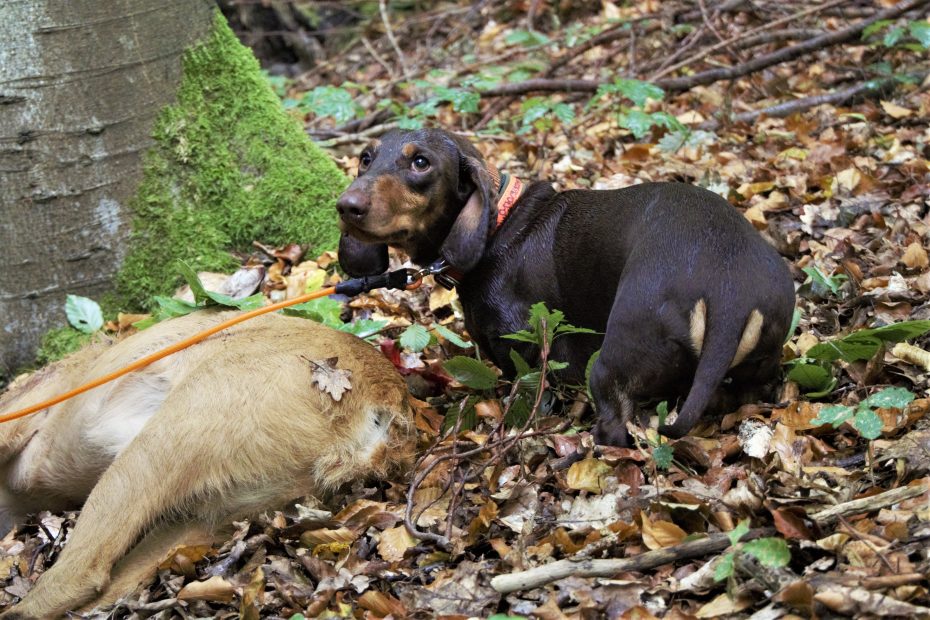Resource guarding is defined by experts as “the use of avoidance, threatening, or aggressive behaviors by a dog to retain control of food or non-food items in the presence of a person or other animal.”[1]
Roots of Resource Guarding Behavior
First, we need to understand where this behavior is coming from. Obviously, survival was not only dependent on hunting success, but also on the ability to claim your part of the prey. Wolves, and also dogs that were not able to stand their ground against other pack members or scavengers eventually starved to death. So, resource guarding is a basic survival instinct. With domestication, individuals were favored that showed a reduced aggression towards humans – but traits that are so deeply imbedded in the brains of predators do not disappear so quickly. And, of course, breeding dogs with high prey drive as it is in the case of hunting Teckels, includes also a strong will to catch, hold, kill, and claim the game they are after. A dog that is able to cope with all obstacles and hardships to find a wounded animal, will most likely have a high interest in keeping the reward for itself. Nevertheless, Teckels are miniature Hounds, and bred also for social pack behavior. So there is a good chance to get an individual that will not show any resource guarding at all when it comes to game, but is happy to tear and rip the game together with its master or other dogs from its pack. But attitudes can change quickly when strangers try to touch the game…
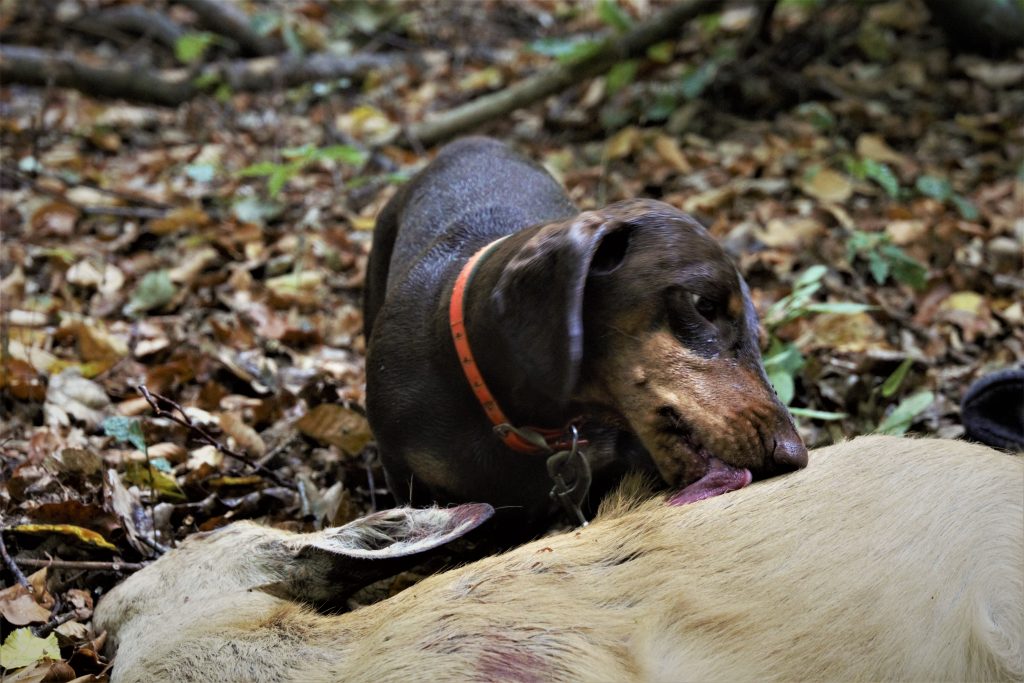
“I found it, its mine”
Blood Tracking and Resource Guarding
Blood trackers are often called to help others find their wounded animals. This means that in many cases, hunters or observers will be around when the dog finds the game. With a dog with an aggressive behavior around game, things can end bad: a happy hunter, in the worst case even a child, tries to pet the tracking dog or touch the trophy, and is then bitten by the dog. When a dog has a history of bad manners around game, warning the hunters and also removing the dog from the game are safety measures. When the dog is even aggressive towards the owner, in the case of a Teckel its not that hard to avoid bleeding fingers: you can easily drag the dog by the tracking leash. Once it is not close to the game, most Teckels loose their bad temper.
But still, it is a risk factor and also an embarrassing moment for the dog handler not to be able to control its Teckel. So, best is to have a tracking dog that is fine with anybody getting close to “its” game.
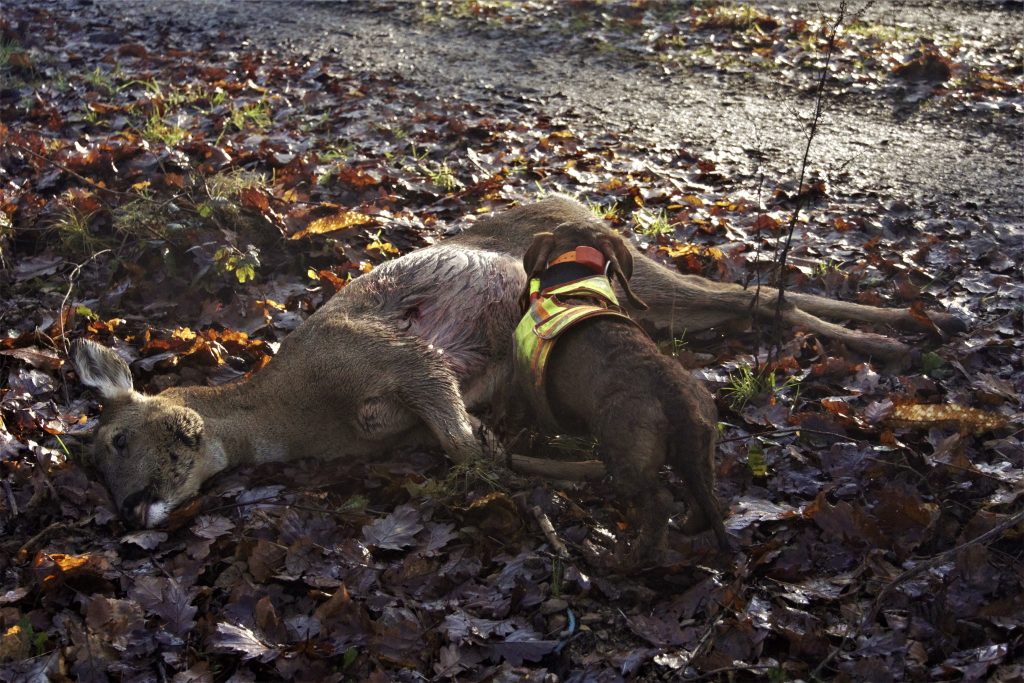
Claiming the game
Starting from Day 1
Teckel puppies are sweet, adorable, and small. Nevertheless, you need to start early with teaching it the right behavior around object with high value to it – not only food, but also toys.
Insecurity, anxiety, and fearfulness are the perfect breeding grounds for many forms of aggression. So, avoid any situations that add to these states of mind, like the following:
- Teasing the puppy with objects or food in order to make it growl or launch at you
- Letting your puppy hoard objects or spare food in its kennel, under furniture etc.
- Brutal and pointless removal of objects or food with force
- Odd behavior of you when puppy has a chewing toy – staring at it, permanent disturbance etc.
In the first couple months, the whole world should be secure and reliable for your dog. There is no need to be anxious about anything. This includes also some basic rules for you and your family members, and also environmental aspects. There should be no dog toys, chewing bones or food lying around – remember, only when you own something you start worrying about it. So, remove toys after playing and chew toys when the dog is not eating it anymore.
Feeding time is training time – there are couple of ways to get your dog used to you being around its food without being a threat. Hold the bowl in your hand while feeding or present your puppy the bowl with your hand in it – it must eat around your fingers. Praise it only with a very calm voice, to avoid creating excitement. Add little pieces of special extra food to the regular food during feeding, so the puppy knows: any time a hand comes close, good thing happen.
At this young age, most puppies are still trustful and get used to this set-up quite fast. If you have a puppy that is avoiding the situation already, being uncomfortable with you close to the food or even growling, then more effort is needed. Play food-related games that create a bond and trust – for example, sit on the ground with a closed hand full of dry dog food. Put your other hand next to it. When your puppy touches the empty hand with its nose, the full one opens up. It shows your young dog that close contact and touch means positive things, and that you are a reliable partner and source of food.
“Leave it” commands are also a playful way of reducing guarding behaviors. If you want to take away something from your puppy, present it something with a higher worth. For example, a piece of meat or cheese. You can pair the release of the primary object with a command and establish it in a non-confrontative way.
Any stranger you meet with your puppy is an opportunity to learn – give him or her dog food to feed your dog, let them pet it. Encourage any friendly behavior and you will later have an adult dog that most likely tolerates the presence of strangers and do not show any aggressive behavior towards them.
Blood Tracking and Resource Guarding
In blood tracking training, your Teckel will most likely be now confronted with real rugs or parts of game. The excitement is high, and of course, your dog should be able to “claim” the game once it found it as reward. So, licking and biting it is ok, and you should not spare with praise. With the training described above, your dog should be ok with you around the rug. Praise friendly behavior, like tail wagging or licking you.
If the genetic trait of guarding objects is very strong in your Teckel, it can now show its ugly face. Suddenly, your friendly dog reacts with a tense body posture, ears back, and maybe even growling at you. Note that this is not necessarily something you did wrong in training or handling your dog, and there is no bad intention behind it. It is an instinctively triggered response to the situation.
It is, in fact, not as easy to cure as other bad behaviors. Take putting the paws on the table as example. It is a behavior the dog learned – putting the paws on the table allow it to reach food, so it is self-reinforcing. By punishing the dog for doing it, it will eventually stop or even avoid the table altogether – when the punishment is stronger than the desire to reach the food.
In case of guarding game, we actively force the situation to happen – it is the equivalent of putting the dog on the table and literally pressing its head into the cookie bowl. We WANT the dog to be in a position that triggers its innate instinct to guard the resource – respectively on or next to the dead animal. We WANT it to be eager, persistent, and totally focused on finding and claiming the game. We WANT it to sniff, lick, and shake it, and maybe even rip parts out of it, which are all behaviors prior to feeding on the prey.
And at the same time, we also want it to act completely opposite to what its instincts told it to do: happy to share the game with us, and friendly to anybody approaching it – maybe even letting itself be picked up for a nice photo with a stranger.
So, if your Teckel is not friendly by nature, it is hard work to get it to this point with training.
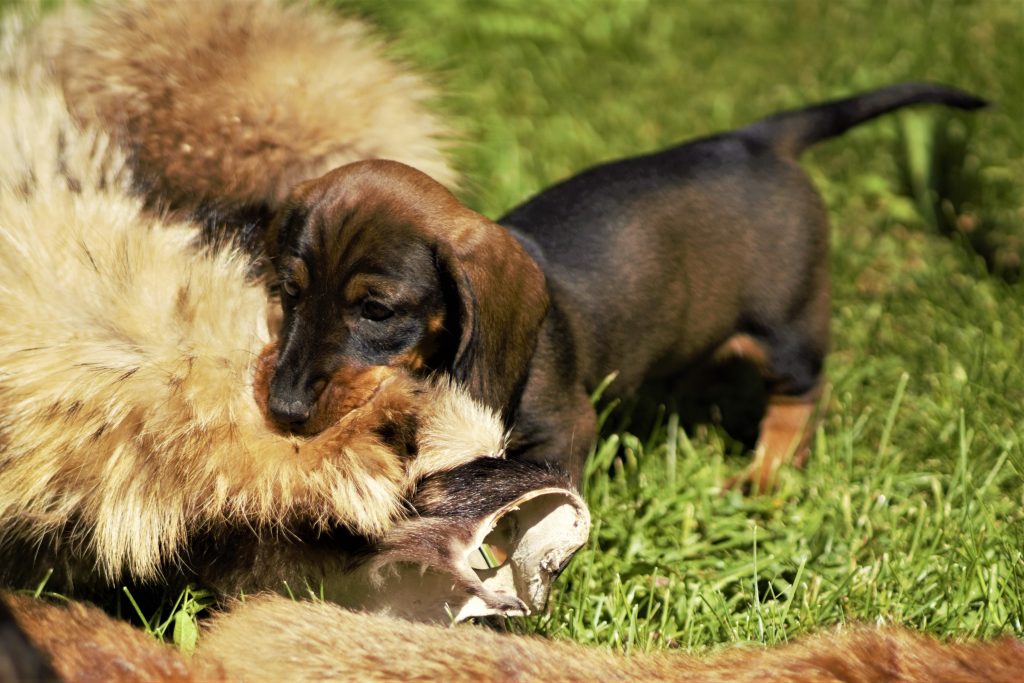
Puppy with a fox rug
Training Approaches
Obviously, wild canines are very aggressive around their prey, but will back off if a much stronger opponent arrives. A jackal will fight a vulture, but no lion. You as owner can therefore also claim the game for yourself. Depending on your overall training style and what punishment you use with your hunting dog, you can make it back away from the game. For some individuals, a strong voice and explicit body language is enough to back away. With a little bit of space between dog and prey, you can then apply known commands as sit or lay down. If the dog tries to stand up and approach the game, you block it and bring it back to the waiting spot. At this point, it is pure obedience.
With this method, your dog obviously will not loose its possessiveness. It simply knows that you are in charge, and it has to obey, or negative consequences will follow. Still, it will not be amused about the situation.
But is there a way to turn an aggressive resource guard by nature into a calm and balanced dog around game? Well, training approaches that rely on acclimatization to the situation are not applicable in the case of blood tracking. When training a food aggressive dog, we can get it used to humans around its food step by step: it learns that our presence is not a threat, as we are not taking the food away.
Obviously, you as blood tracker and the hunter that accompanies you will not lay down next to the trophy animal face down, letting the tracking dog rip it apart piece by piece in order to show it that humans do not pose a threat at all. You WILL take over the game and separate the dog from it, that is the whole reason doing a blood track at all.
So, strict obedience is a way to cope with such a dog. Although in the most cases, you will not follow through with the training when at the end of a real blood track. Emotions take over, the hunter wants to chat or make photos, its dark or rainy and everyone wants back to the truck and so on… even with the best of intentions when starting the track, at the end you will drag your aggressive dog on the leash away from the game and tie it up somewhere.
So, training should be done at home, with much patience and time.
Tips for Training at Home
Get a rug, a deer head, anything big enough that your dog can´t carry it away on its own. Start the training in an easy way, by letting your dog sit or lie down far away from it. It should be able to stay away from the game for 1, 5, and up to 30 minutes – or as long as it takes to field-dress it.
Manipulate the rug in front of your dog, touch it drag it, pick it up and walk around with it. Your dog should stay at the waiting stop, no matter what happens.
Take your dog at the leash and walk past the rug, first in big circles, then getting smaller and smaller. You dog should literally be able to walk over it without claiming it.
Establish a “take it” command, where the dog is allowed to shake and tear the rug. With “leave it” or “back off”, it should let go. Attack the rug to a fishing rod, play with your dog to get it to a state of high excitement, and then apply the command.
For the trainers with high ambitions, you can train your dog to announce its find with barking. This means if it finds a rug, it should stay on it and bark until the handler arrives. This gives the dog an alternative opportunity to act when at the game. Instead of being possessive, it follows through with its learned behavior and gets a reward.
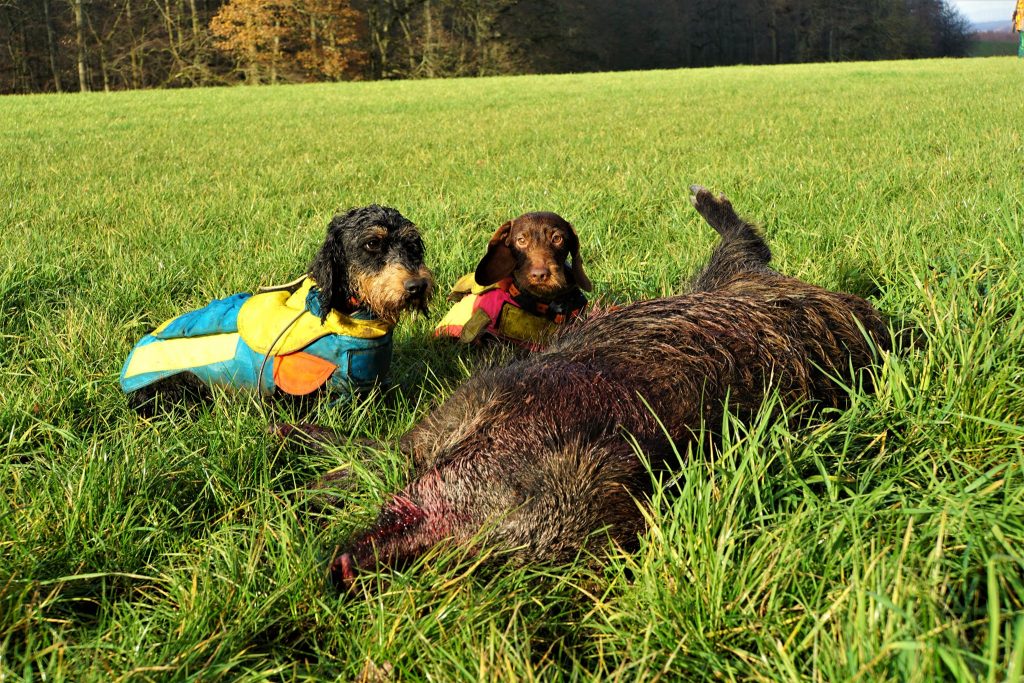
Sitting together peacefully next to a boar is a matter of obedience
[1] Jacobs JA, Coe JB, Widowski TM, Pearl DL, Niel L. Defining and Clarifying the Terms Canine Possessive Aggression and Resource Guarding: A Study of Expert Opinion. Front Vet Sci. 2018;5:115. Published 2018 Jun 11. doi:10.3389/fvets.2018.00115
